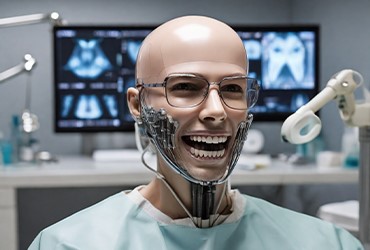AI-Driven vs. Human-Driven Dentistry: What’s the Difference in Patient Care?

In recent years, Artificial Intelligence (AI) has been making waves in various fields, including healthcare. Dentistry is no exception. With AI-driven tools and technologies becoming more prevalent, patients might wonder: How does AI-driven care compare to traditional, human-driven dental care? In this blog, we’ll explore the differences, benefits, and potential drawbacks of AI-driven and human-driven approaches to patient care in dentistry.
Diagnostic Accuracy: The Power of AI vs. Human Expertise
- AI-Driven Diagnostics: AI excels in analyzing large amounts of data quickly and accurately. When it comes to diagnosing dental issues, AI-driven tools can analyze X-rays, intraoral scans, and other dental images with incredible precision. AI can detect cavities, signs of gum disease, and even early stages of oral cancer that might be missed by the human eye. The consistency and thoroughness of AI analysis help ensure that nothing is overlooked.
- Human-Driven Diagnostics: Dentists rely on years of education, training, and experience to diagnose dental problems. While AI can provide precise readings, human dentists bring intuition, experience, and the ability to interpret subtle nuances in patient symptoms that a machine might miss. Additionally, dentists can take into account a patient's medical history, lifestyle, and personal preferences, which are vital in making a well rounded diagnosis.
My opinion: AI enhances diagnostic accuracy, especially in detecting issues at an early stage. However, human judgment is essential for considering the broader context of a patient’s health and making holistic decisions.
Personalized Treatment: Tailored by Technology vs. Crafted by Care
- AI-Driven Treatment Plans: AI can generate treatment plans based on the analysis of patient data, predicting the most effective interventions based on similar cases. AI considers a wide range of factors, including dental history, current health status, and genetic predispositions, to tailor treatment plans to the individual needs of each patient.
- Human-Driven Treatment Plans: While AI can provide data-driven recommendations, dentists are adept at crafting personalized treatment plans that align with a patient’s unique circumstances. Dentists consider not only the technical aspects of care but also the patient’s comfort level, fears, and lifestyle, ensuring that the proposed treatment is both effective and acceptable to the patient.
My opinion: AI can offer highly personalized treatment plans, but the human touch is vital for tailoring these plans to fit a patient’s unique situation and preferences.
Patient Interaction: Tech-Savvy vs. Empathy-Driven
- AI-Driven Interaction: AI can handle various aspects of patient interaction, such as virtual consultations, appointment scheduling, and even answering common patient queries. These systems are efficient, available 24/7, and can provide quick responses, making the administrative side of patient care more streamlined.
- Human-Driven Interaction One of the most significant advantages of human-driven care is the ability to provide empathy and emotional support. Dentists and their teams can build relationships with patients, offering reassurance, understanding patient concerns, and addressing anxieties, especially for those who fear dental procedures. This human connection plays a crucial role in patient satisfaction and overall experience.
My opinion: AI improves efficiency and accessibility in patient interaction, but it cannot replace the empathy, reassurance, and trust that human interaction provides.
Efficiency and Workflow: Automated Precision vs. Experienced Flexibility
- AI-Driven Efficiency: AI is highly effective in automating routine tasks, such as appointment reminders, billing, and inventory management. This allows dental practices to run more smoothly and frees up time for dental professionals to focus on patient care. In clinical settings, AI can assist in procedures by providing real-time data analysis, which can help in making swift decisions.
- Human-Driven Flexibility: Dentists and their teams bring adaptability to patient care. Unlike AI, humans can respond to unexpected situations, such as a patient’s sudden discomfort during a procedure or an emergency that requires immediate attention. Human-driven workflows can also be adjusted on the fly to accommodate individual patient needs.
My opinion: AI enhances efficiency, particularly in administrative and data-driven tasks, but human flexibility is essential for adapting to real-time changes and emergencies in patient care.
Long-Term Care: Predictive Algorithms vs. Preventive Wisdom
- AI-Driven Long-Term Care: AI’s ability to predict the progression of dental conditions is a major asset in long-term care planning. By analyzing trends in a patient’s dental history, AI can forecast potential issues and suggest preventive measures, which can be incorporated into long-term care plans.
- Human-Driven Long-Term Care: Dentists use their experience and knowledge of the patient’s overall health to develop preventive strategies that go beyond algorithms. They can provide personalized advice on lifestyle changes, diet, and oral hygiene practices that AI might not fully address. Moreover, the relationship built over years of care allows dentists to understand their patients’ needs deeply and adjust care plans as necessary.
My opinion: AI’s predictive capabilities are a powerful tool for long-term care, but the wisdom and personalized guidance from human-driven care remain irreplaceable.
Conclusion: The Best of Both Worlds
AI is undoubtedly transforming dentistry by enhancing diagnostic accuracy, improving efficiency, and offering personalized care. However, it’s important to recognize that AI is a tool, that works best when combined with the expertise, empathy, and adaptability of human dentists.
For patients, the ideal dental care experience integrates the strengths of both AI and human-driven approaches. AI can handle the technical aspects, ensuring precision and efficiency, while your dentist provides the personal care, empathy, and nuanced decision-making that technology cannot replicate.
In the end, the goal is to provide the highest quality of care for patients. As AI continues to evolve, it will become an even more integral part of dentistry, but it will always work alongside the skilled professionals who are dedicated to keeping your smile healthy and bright.